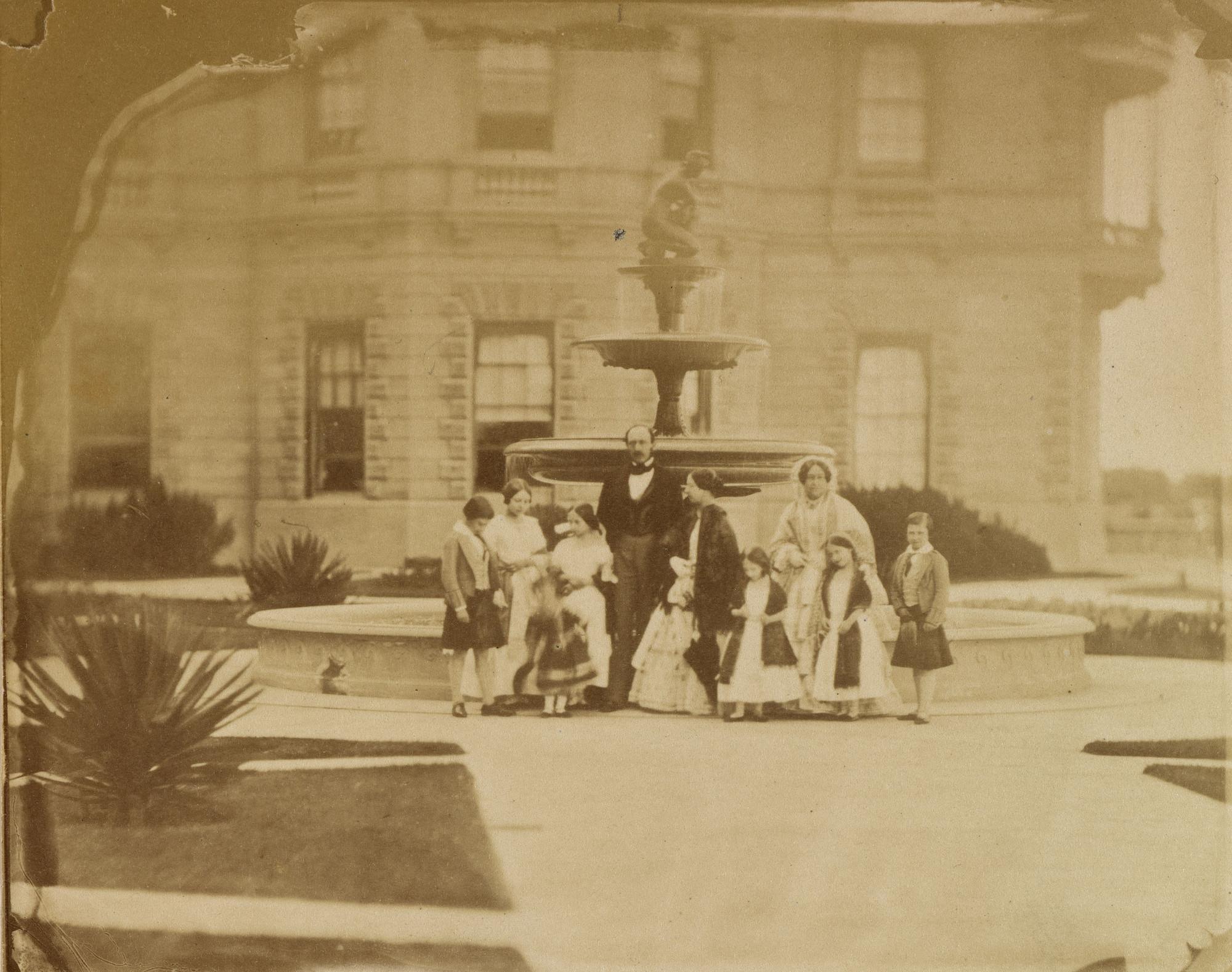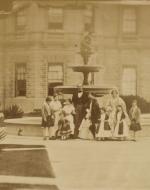Created by Margaret Barcinski on Fri, 10/23/2020 - 12:17
Description:
After Queen Victoria ascended to the throne in 1837, the popularity of a different form of royal representation became more popular (Reynolds & Matthew 11). Most monarchs before Queen Victoria had had their portraits painted as a symbol of their status and power (Plunkett 69). While Queen Victoria herself had portraits commissioned, the symbolism behind the portraits changed with the dawn of a new form of representation in photography, leading to a subsequent decline in portraiture of future monarchs that began after the Victorian era. Having been invented and introduced in Paris in 1821, photography reached London by 1839. Photography encouraged a more relatable image of monarchs, less political and more personal to their subjects.
When Queen Victoria permitted certain images of her family and her to be released and shared with the public, there was a rush to distribute her image. Soon, various venders were selling prints, engravings, and photographs of the royal family, either selling them separately or including them in a variety of media ranging from periodicals to newspapers (Plunkett 68). This access to images of the royal family allowed for the average person to document different events in Queen Victoria’s life and made her more relatable to her subjects when seen doing activities like interacting with her children as a mother. Some of the most popular and represented events included Victoria’s coronation, her marriage with Prince Albert, some of the christenings of her children, and Queen Victoria and Prince Albert in portrait after Albert died (Plunkett 72). Being inexpensive and even featured in newspapers for people to cut out, many people gained access to these images (Plunkett 71-72). Individuals of different classes were now able to access a glimpse of their queen, making her more accessible than previous monarchs. Due to the intense popularity of these representations of the Queen, the term ‘Reginamania” was coined to describe the enormous focus on Queen Victoria by the public and the emphasis on her physical qualities and image as a proper Victorian woman and queen (Plunkett 69).
Even Queen Victoria herself appreciated photography and contributed to its growth in popularity during her reign. Victoria supported her husband, Prince Albert, in his efforts to establish the first Great Exhibition of 1851 in representing industrial techniques from a diverse range of countries, where some of their subjects had an opportunity to view photographs for the first time (“Getty Explores Queen Victoria's Lifelong Relationship with Photography in Upcoming Exhibition”). However, Victoria and Albert also joined the Photographic Society of London and were able to give royal support to other institutions where photography was displayed (“Getty Explores Queen Victoria's Lifelong Relationship with Photography in Upcoming Exhibition”).
Victoria and Albert took up photography themselves, having their own private darkroom in Windsor Castle where many of their family photographs were developed (Christie 24). They often assembled albums of their photographs together and even shared them as gifts, items that Victoria later frequently viewed after her husband’s death (Christie 25-26). In many of these photographs with her family, Queen Victoria often appears to sit in profile, with or without a bonnet to hide her face (“Getty Explores Queen Victoria's Lifelong Relationship with Photography in Upcoming Exhibition”). This was partly as a result of her initial experiences with photography with long exposure times for taking photographs, resulting in her eyes being closed in some of them (“Getty Explores Queen Victoria's Lifelong Relationship with Photography in Upcoming Exhibition”).
Victoria and Albert also shared their passion with their nine children as well, encouraging them to use their cameras and use the wet process for developing their photographs (Christie 25). The full extent of the popularity of photography within their household is unknown due to one of their children burning many of the photos not in albums after Victoria’s death, but over 100,000 photographs remain today, accumulated in 110 albums, to document their passion for photography (Christie 26). These photographs therefore depicted Victoria, Albert, and her children at different times in their lives, though they also later included their extended family.
Over the course of her marriage with Prince Albert of Saxe-Coburg and Gotha, Queen Victoria had nine children: Princess Victoria (also referred to as Vicky), Prince Albert Edward, Princess Alice, Prince Alfred, Princess Helena, Princess Louise, Prince Arthur, Prince Leopold, and Princess Beatrice (Reynolds & Matthew 44-45). Queen Victoria’s relationship with her children was one in which she appreciated her children and the family they were able to establish (Reynolds & Matthew 44). However, though she appreciated them, she had some conflicting feelings depending on their behavior, appearance, and skills and intelligence (Reynolds and Matthew). While each of the children connected with her through photography, there were different expectations she had from each of them. Most of these expectations arose from the fact that only a few of her children had the possibility of ascending to the throne over time, with all nine of her children being unlikely to fill a role as a monarch in their lifetime. Therefore, it was Princess Vicky, Prince Albert Edward, and Princess Alice, the three oldest children, who faced the highest expectations from the Queen and Prince Albert, receiving extensive tutoring and lessons in behavior to teach them skills for becoming a good monarch (Reynolds & Matthew 44-45). Her relationships with her remaining younger children, Alfred, Helena, Louise, Arthur, Leopold, and Beatrice, were considered markedly more affectionate, as they did not have the same role to fill (Reynolds & Matthew 45). She even had favorites among these children, with Arthur and Beatrice being her favorites, though she was also very protective of Leopold due to his poor health (Reynolds & Matthew).
Works Cited:
Becker, E. Queen Victoria, the Prince Consort, and their children with the Duchess of Kent 1854 [Photograph of a group portrait of Queen Victoria and Prince Albert with their seven eldest children and Queen Victoria's mother, the Duchess of Kent. The group are posed in front of a fountain at Osborne House. The group stand, positioned from left to right are: Albert Edward, Prince of Wales, Princess Victoria, Princess Royal, Prince Arthur, Princess Alice, Prince Albert, Queen Victoria, Princess Louise, the Duchess of Kent, Princess Helena and Prince Alfred.]. Retrieved October 22, 2020, from https://www.rct.uk/collection/search#/2/collection/2143858/queen-victoria-the-prince-consort-and-their-children-with-the-duchess-of-kent
Caldesi, L. The Royal Family at Osborne May 1857 [Photograph of a group portrait of Queen Victoria and Prince Albert with their family taken in the grounds of Osborne House. The photograph depicts, from left to right, Prince Alfred, Prince Albert, Princess Helena, Princess Alice, Prince Arthur, Queen Victoria holding Princess Beatrice in her arms, Princess Victoria, Prince Leopold and Prince Albert Edward of Wales. The family pose in front of a sculpture of a full length female figure, positioned in in an alcove. There is a balustrade to the left of the group.]. Retrieved October 22, 2020, from https://www.rct.uk/collection/search#/9/collection/2106421/the-royal-familynbspat-osborne
Christie, Ian. “‘A Very Wonderful Process’: Queen Victoria, Photography and Film at the Fin De Siècle.” The British Monarchy On Screen, edited by Mandy Merck, Manchester University Press, Manchester, 2016, pp. 23–46. JSTOR, www.jstor.org/stable/j.ctt1wn0s87.7. Accessed 7 Oct. 2020.
“Getty Explores Queen Victoria's Lifelong Relationship with Photography in Upcoming Exhibition.” Targeted News Service, 19 Nov. 2013. U.S. Newsstream, ezproxy.depaul.edu/login?url=https://www-proquest-com.ezproxy.depaul.edu/docview/1459529843?accountid.... Accessed 22 Oct. 2020.
Plunkett, John. Queen Victoria : First Media Monarch. Oxford University Press, 2003.
Reynolds, K. D., and H. C. G. Matthew. Queen Victoria, Oxford University Press, 1995. ProQuest Ebook Central, https://ebookcentral.proquest.com/lib/depaul/detail.action?docID=430521.



